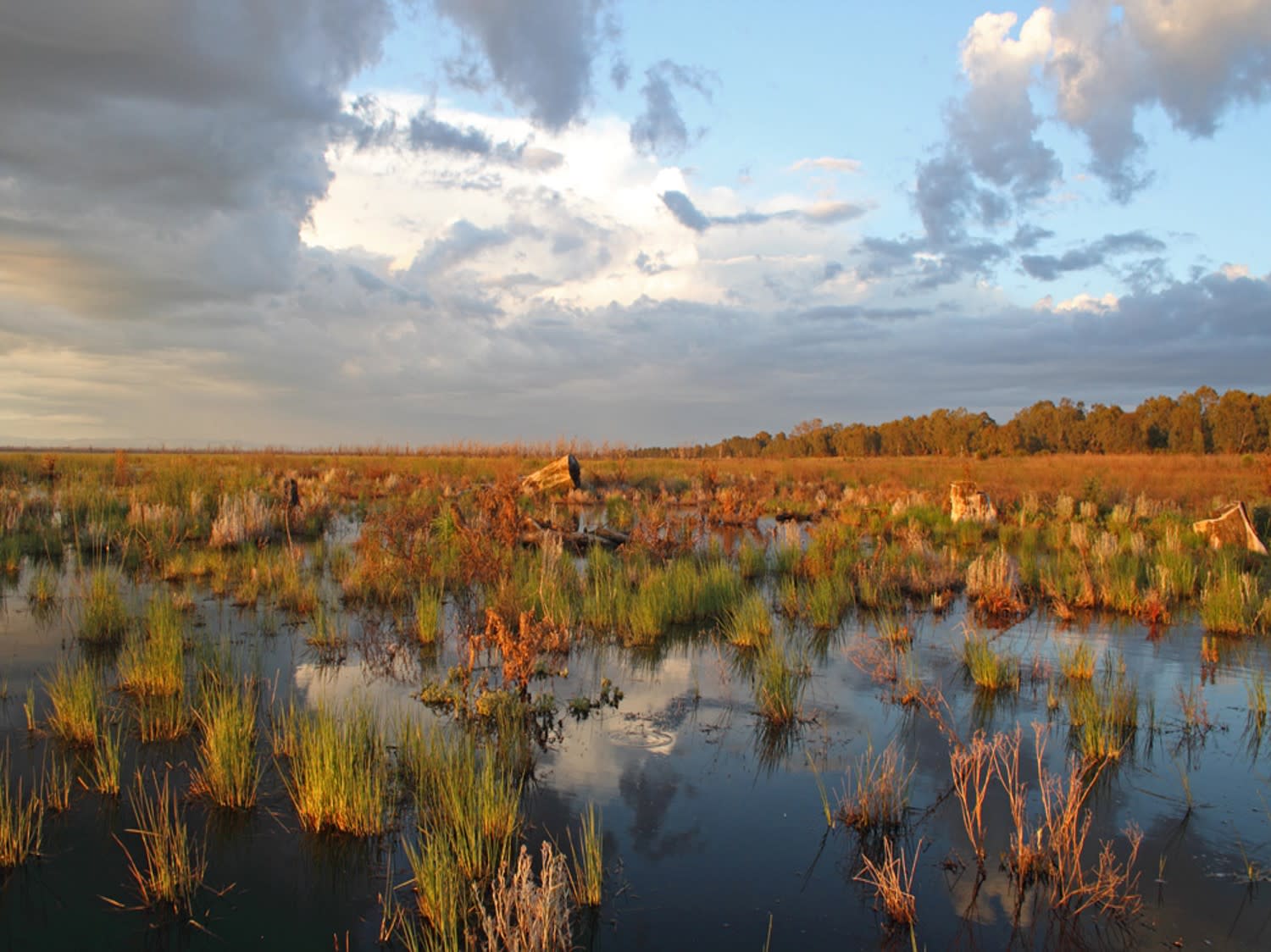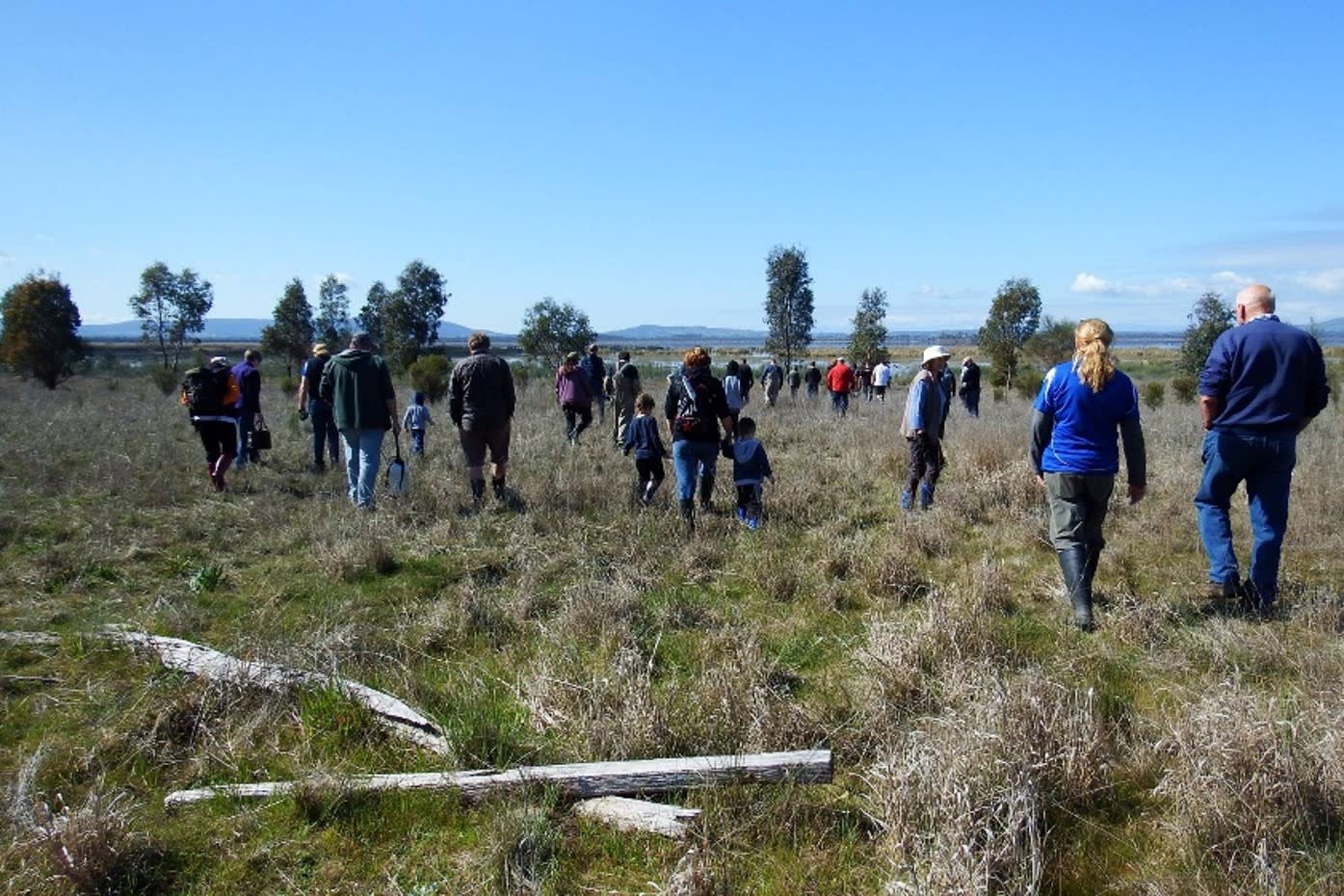
Winton Wetlands
About
GENERAL INFORMATION
Criteria:
- Protects biological diverse wetland flora, fauna and/or their habitat
- Supports significant numbers of wetland-dependent fauna, such as water birds or fish
Winton Wetlands are a series of thirty temporary and intermittent wetlands, the smallest being 2 ha and the largest being Winton Swamp at 1,800 ha. Winton contains the largest communities of open cane grasslands and river redgum wetlands in the region, all set within a natural features reserve of 8,750 ha. Constructed habitats include the Mokoan Ponds, deep enough to hold permanent water.
Winton Wetlands contains 3,800 ha of wetlands, supporting the largest area of seasonal/intermittent freshwater lakes in the region, and is surrounded by 4,950 ha of water dependent river red gum and box grassy woodlands. Winton, Sergeants and Greens Swamps cover some 3,000 ha of seasonally inundated lakes, and are not well-represented in protected wetlands sites within the broader landscape (Murray-Darling Basin).
Nineteen of the thirty wetlands recorded ‘excellent’ overall condition in an assessment of the wetland condition (Hamilton 2013) containing unaltered hydrology and bathymetry, excellent water quality, diverse indigenous flora, and largely undisturbed vegetation buffers. The site supports 180 native species of birds, fish, frogs, reptiles, bats and plants. Winton Wetlands is among the largest ephemeral wetlands in Victoria, and with its diversity of habitat and restoration in progress, qualifies for State significance for biodiversity conservation (Barlow 2011). In addition, at least twenty-nine species listed under Victorian state Legislation are endangered or at risk.
Exemplary Ecosystem Services:
- Maintains ecological connectivity/cohesion
- Recreation (birdwatching, ecotourism)
- Education
CONSERVATION STATUS AND THREATS
Public Access: Yes
Current and Future Threats: Pest Plants and animals (current with a control plan in place); water quality (control plan in place) and Climate change (future with water management strategies being developed and implemented to mitigate and adapt to potential changes)
Conservation status: State/Province/Regional Protection
Adjacent Land Use: Ranchland (pasture, grazing)
Approximate natural buffer width:
- > 100 ft
Other information:
Some smaller areas of crops, vineyards and orchards
Some low density residential land adjacent (overlooking) to the site
ECOLOGY
General wetland characterization:
- Inland Fresh Seasonally Flooded Basin/Flat
- Inland Fresh Meadow
- Inland Shallow Fresh Marsh
- Inland Deep Fresh Marsh
- Inland Open Fresh Water
- Inland Fresh Wooded Swamp
Adjacent Water Bod(ies):
- Lake
- Pond
- Stream
Name of body of water: Winton Creek, Seven Mile Creek, 11 Mile Creek and Show Creek
Surficial Geology:
Dark gradational calcareous clays are found on swamp floors and similarly gilgai soils in slightly more elevated areas where wetting and drying is common. Drainage lines traverse highly dispersive soils surrounding wetlands. Wind-blown (aeolian) material accumulated on the eastern side of Winton Swamp forming south-easterly lunettes in the Murray-Darling Basin. Slopes running off adjacent hills are gravelly outwash material (colluvial pediments) overlying yellow and red clays.
If Adjacent to Stream, stream order: 3
Soils:
The soils of the site are a cracking clays with a organic layer in active wetland sites. No publications exist on soil type.
FLORA AND FAUNA
Dominant flora: The wetlands are large Cane Grass, River Red Gum wetlands surrounded by substantial areas of River Red Gum and Grey Box grassy woodlands. The site has over 200 native plant species but at most times of the year the wetlands will be dominated by Cane Grass and River Red Gums, with large areas of Juncus spp. and Typha spp. Reedbeds, large areas of aquatic plants like Milfoil (Myriophyllum spp.) and mudflat plants made up of blown grass (Lachnagrostis filiformis)and old man weed (Centipeda cunninghami) are also present.
Unique flora: Southern Cane Grass (Eragrostis infecunda) is a unique species for the site which is expanding (Roberts and Looby 2019) in both distribution and abundance as measured in surveys in 2010 and 2017. We have observed the species expanded greatly in 2016 to 2018 following extensive flooding in Greens, Winton and Sergeants Swamp returning the species to unique status of the largest canegrass swamp within the region. The rush, Juncus semisolidus, is a native perennial rush that has been a conspicuous part of the self-regenerating vegetation since at least 2006. It has been an early coloniser, following water level recession with it's abundance increasing at some wetlands and decreasing at others but is present across the site. Blown grass (Lachnagrostis filiformis var 1), is a shorter lived native grass and is unique in being one of only a few plants that has had very variable abundances which are influence by seasonal conditions. In 2010 it was abundant on the Floor of large wetlands but not in 2017 but abundant again in 2019 (by observation).
Dominant fauna: The fauna is variable across space and time given the vast and diverse nature of the Reserve. During the wet phase the reserve will be dominated by waterbirds with up to 10,000 Grey teal present at any one time and hundreds of individuals of a suite of water birds such as pelicans, waterfowl, egrets and spoonbills. Murray cod and native carp Gudgeon will be dominant in the permanent water bodies which also provide refuge to many waterbirds, frogs and freshwater turtles over the times the rest of the site is dry. A pair of White-bellied Sea-eagles are present and range across the whole site, and these have bred on site at least twice in the last three years. We have large numbers of eastern grey kangaroos and swamp wallabies that dominate the grasslands on the perimeter of the wetlands.
Rare fauna: We have a unique raptor community on site. Not only is there the White-bellied Sea-eagles, we also have a diverse range of raptor species including kestrels, falcons and kites. We have a unique range of aquatic reptiles, large bodied turtles such as the Eastern Snake-necked Turtles and the Murray River Turtle, with signs that both species are breeding. Turtles are present across the site in the wetter months (and, smaller, permanent populations are present in our Mokoan Ponds). We also have an extensive population of red-bellied black snakes which breed onsite and feed upon the expanding frog populations during wet phases. In 2017, we had the first colonial breeding event of the Nankeen Night Heron (Nycticorax caledonicus), at Ashmeads Swamp and the juvenile birds from that event were then sighted across many of the wetland sites during the following year. The Australian native water rat, the Rakali (Hydromys chrysogaster) has returned to the site with the restoration of habitat of the Mokoan Ponds and the creation of corridors between the local creek and our site. Phascogales, Sugar-gliders and Antechinus are regularly seen in the surrounding woodland buffer by visiting animal specialists.
ADDITIONAL INFORMATION
Winton Wetlands IWC Assessment 2012
Winton Wetlands Restoration and Monitoring Strategic Plan
Winton Wetlands bird survey – phase 1 review
Winton Wetlands Annual Report 2018-2019
Winton Wetlands Revegetation Review
Seven years on: a re-survey of the vegetation of Mokoan Reserve, autumn 2017
CONTACT INFORMATION
Applicant First Name: Lance
Applicant Last Name: Lloyd
Applicant E-mail Address: lance.lloyd@wintonwetlands.org.au
Images



